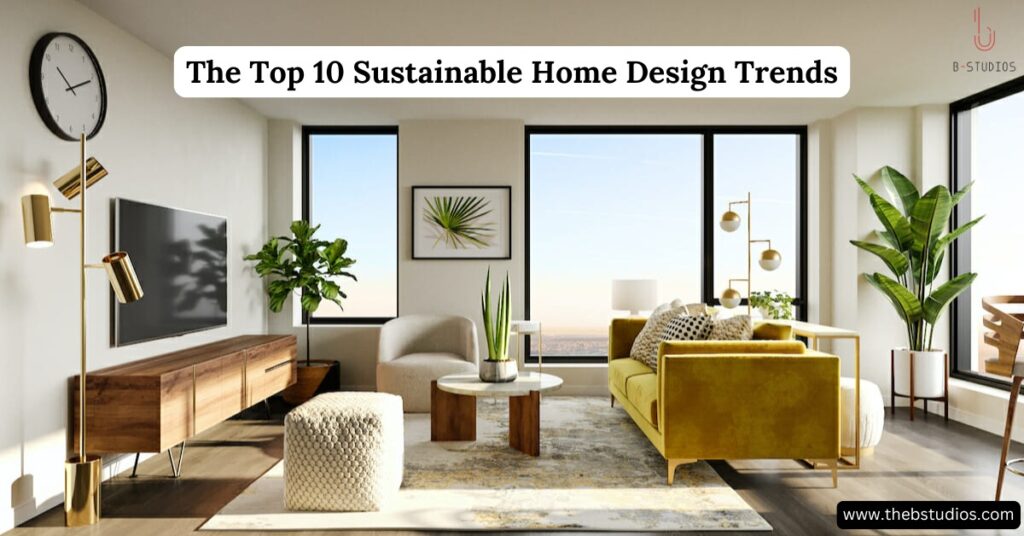Introduction
Over the past few years, the importance of sustainable home design has been much more pronounced. Homeowners look for ways to reduce emissions in global conversations about climate change and environmental issues. Sustainable home design is not only eco-friendly but also guarantees health maintenance for the people around it and saves costs for the long term. In this article, we’ll investigate the latest ten home interior design trends that provide the basis for the future of residential living.
Trend 1: Energy-Efficient Appliances
The adoption of energy-efficient appliances is one of the biggest trends in sustainable home design. These benefits come in the form of lower electricity consumption, greenhouse gas emissions, and utility bills.
Benefits of Energy Efficiency:
- Energy conservation
- Energy bill savings
- Reducing environmental pollution
Popular Energy-Efficient Appliances:
- Appliances like Energy Star-rated refrigerators and dishwashers
- Efficient washing machines and dryers
- LED lighting
Trend 2: Solar Power Integration
Solar energy has moved from a theory to a practical solution for reducing the use of fossil fuels. Its advancements have led to solar panels being more efficient and cheaper.
Solar Technology Revolution:
- Higher efficiency of solar panels
- Lower installation costs
- Usage of batteries for energy storage
Advantages of Solar Panels for Houses:
- Lower electricity bills
- Reduced carbon emissions
- Possibility of self-sufficiency in energy
Trend 3: Green Roofs and Walls
The green roofs and walls are not just a beautifying addition but they also have a lot of environmental benefits. These characteristics comprise the practice of vegetation growing on the roof or walls of a building.
What Are Green Roofs and Walls?
- Roofs and walls that are covered with plants and vegetation
- Applications of the specialized structures for plant growing
Environmental and Health Benefits:
- Cleaner air
- Greater insulation and energy efficiency
- Heat island effect reduction
Trend 4: Sustainable Building Materials
Sustainable construction materials should be taken into account when it comes to minimizing the negative consequences on the environment. These materials are often waste-free, reclaimed, or harvested from sustainable resources.
Types of Sustainable Materials:
- Bamboo and cork
- Recycled steel and concrete
- Reclaimed wood
Advantages of Using Sustainable Materials:
- Lower carbon footprint
- Reduced waste
- Durability and longevity
Trend 5: Water Conservation Systems
Water conservation is a central principle in the ecologically conscious design of a house. Introducing eco-friendly systems for water usage helps to save it, to cut down the utility costs.
Water Conservation Devices:
- Rainwater harvesting systems
- Low-flow fixtures
- Greywater recycling systems
Water Preservation:
- Protection of freshwater resources
- Pay less for the water
- Less pollution to nature
Trend 6: Smart Home Technology
Smart home technology often, I would say, takes a house to a higher level of sustainability. These devices simplify and optimize energy consumption, thus rendering the dwellings more efficient.
Integration of Smart Technology for Sustainability:
- Smart thermostats
- Automated lighting systems
- Smart irrigation controllers
Opting for such home devices for Smart home technology:
- Nest Thermostat
- Philips Hue lighting
- Rachio Smart Sprinkler Controller
Trend 7: Passive House Design
Passive house design involves the innovative approach of building such energy-efficient places that they take a minimal toll on the ecosystems. This sustainable design philosophy revolves around such ingredients as insulation, airtightness, and energy recovery.
Key Principles of Passive House Design:
- Highly insulated
- Airtight building
- Heat recovery ventilation
Passive House Benefits:
- Drastically low energy consumption
- Improved indoor comfort
- Cost-saving on heating and cooling
Trend 8: Indoor Air Quality Improvement
Indoor air quality is a critical factor for the maintenance of a healthy living environment. The relationship between air quality and respiratory diseases means that improving air quality is a trend in the design of eco-sustainable houses.
Importance of Good Indoor Air Quality:
- Health benefits
- Decreased likelihood of respiratory illnesses
- Boosted general contentment
Methods to Improve Indoor Air Quality:
- The use of air purifiers
- Addition of plants
- Systems of ventilation
Trend 9: Waste Reduction Strategies
Top-notch plans for reducing waste matter a lot for a green lifestyle. These plans focus on preventing waste creation to begin with. Also, they make recycling and composting work better.
Effective Waste Reduction Strategies:
- Composting organic waste
- Recycling programs
- Reducing single-use plastics
The recycling and composting methods help to recycling and composting:
- Waste in landfills has been
- Conservation of resources
- Reduction of greenhouse gas emissions
Trend 10: Natural Lighting
To make the most out of natural lighting in your home, it is possible to do without artificial lighting and improve the general mood of your living spaces.
Benefits of Natural Lighting:
- Energy savings
- Improved mood and productivity
- Connection to the outdoors
Techniques to Maximize Natural Light:
- Large windows and skylights
- Use of light-colored interior finishes
- Strategic placement of mirrors
Conclusion
Eco-friendly house design is beyond fashion; it is the only way to our planet’s future. By the use of all these top 10 sustainable house design trends with the help of B-studios, homeowners can create an eco-friendly, money-saving, and healthier living space. From energy-saving equipment to a passive house design, these trends give different advantages that lead to a sustainable lifestyle.
